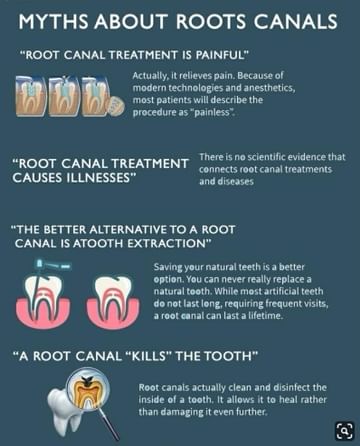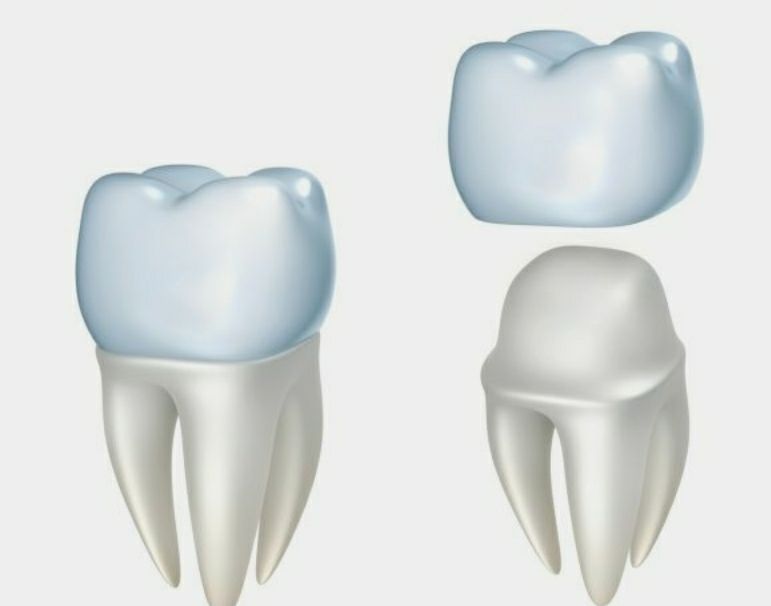Get the App
For Doctors
Login/Sign-up
About
Health Feed
Find Doctors
Health Packages
AllQ&AsTipsQuizzes
Root canal Tips
Last Updated: 6 years ago• Featured Tip
Share
Bookmark
Report
Last Updated: 6 years ago• Featured Tip
Share
Bookmark
Report
Dentist•Jalandhar
Last Updated: 6 years ago• Featured Tip
Share
Bookmark
Report
A root canal is a treatment to repair and save badly damaged or infected tooth. The procedure involves removing the damaged area of the tooth (the pulp), cleaning and disinfecting it and then filling and sealing it. The common causes affecting the pulp are cracked tooth, a deep cavity, repeated dental treatment to the tooth or trauma. The term "root canal" comes from cleaning of the canals inside the tooth's root.
Millions of teeth are treated and saved each year with the root canal, or...more
Millions of teeth are treated and saved each year with the root canal, or...more
Last Updated: 6 years ago• Featured Tip
Share
Bookmark
Report
Having your dentist say to you that you need a root canal, can be a daunting affair. This means that the pulp or soft tissue inside a tooth has been damaged by bacterial infection. A root canal involves removing the damaged pulp, cleaning the infection and filling in the emptied space. Not every tooth infection requires a root canal and hence it is essential to know the indication of a root canal.
Here are a few situations when a root canal may be needed:
Pain: Discomfort rangi...more
Here are a few situations when a root canal may be needed:
Pain: Discomfort rangi...more
Last Updated: 6 years ago• Featured Tip
Share
Bookmark
Report
When a tooth is decayed or accidentally fractured and reaches to the sensitive vital part of the tooth, the pulp, it can be risky to just fill and leave.
Risk is that the root canal gets infected which may lead to pus formation below causing swelling, severe pain, fever and over time it can lead to more severe complications like granuloma, cyst or tumor formations.
So basically root can treatment is performed to eliminate future complications. In this, we remove everything inside the c...more
Risk is that the root canal gets infected which may lead to pus formation below causing swelling, severe pain, fever and over time it can lead to more severe complications like granuloma, cyst or tumor formations.
So basically root can treatment is performed to eliminate future complications. In this, we remove everything inside the c...more
Last Updated: 6 years ago• Featured Tip
Share
Bookmark
Report
Last Updated: 6 years ago• Featured Tip
Share
Bookmark
Report
Last Updated: 6 years ago• Featured Tip
Share
Bookmark
Report
Root canal therapy (RCT) followed by a crown is the most common mode of treatment for severely decayed teeth. However, this is not devoid of failure. In another case, if a tooth could not be salvaged by RCT, then extraction followed by a bridge (replacing the removed tooth with support from adjacent healthy teeth) became the next best option.
In both cases, especially latter, healthy teeth are being manipulated to support the tooth being replaced. The next quest was to work without touc...more
In both cases, especially latter, healthy teeth are being manipulated to support the tooth being replaced. The next quest was to work without touc...more
Last Updated: 6 years ago• Featured Tip
Share
Bookmark
Report
Most of the people dread visiting the dentist for a root canal treatment, owing to the myths associated with it. What is also commonly seen is that the fear is based on someone else's experiences and not of their own. The perception that this treatment is painful stems from early treatment methods which were used. Advancement in the field of endodontics as well as the use of effective anesthesia aid in making this procedure relatively painless and safest way to save a natural tooth. It's importa...more
225 people found this helpful
Last Updated: 6 years ago• Featured Tip
Share
Bookmark
Report
Usually, people ask why we need a crown after root canal treatment. As we removed the decayed part of tooth during the treatment, remaining tooth structure is not sufficient to bear the masticatory load and it might fracture. Moreover, root canal treated tooth don't have blood supply which makes tooth brittle hence prone to fracture. What is the use of root canal treatment when eventually you will end up breaking your tooth.
Crowns are mandatory after root canal treatment.
Crowns are mandatory after root canal treatment.
Book appointment with top doctors for Root canal treatment
View fees, clinic timings and reviews
Ask a free question
Get FREE multiple opinions from Doctors
posted anonymously


















